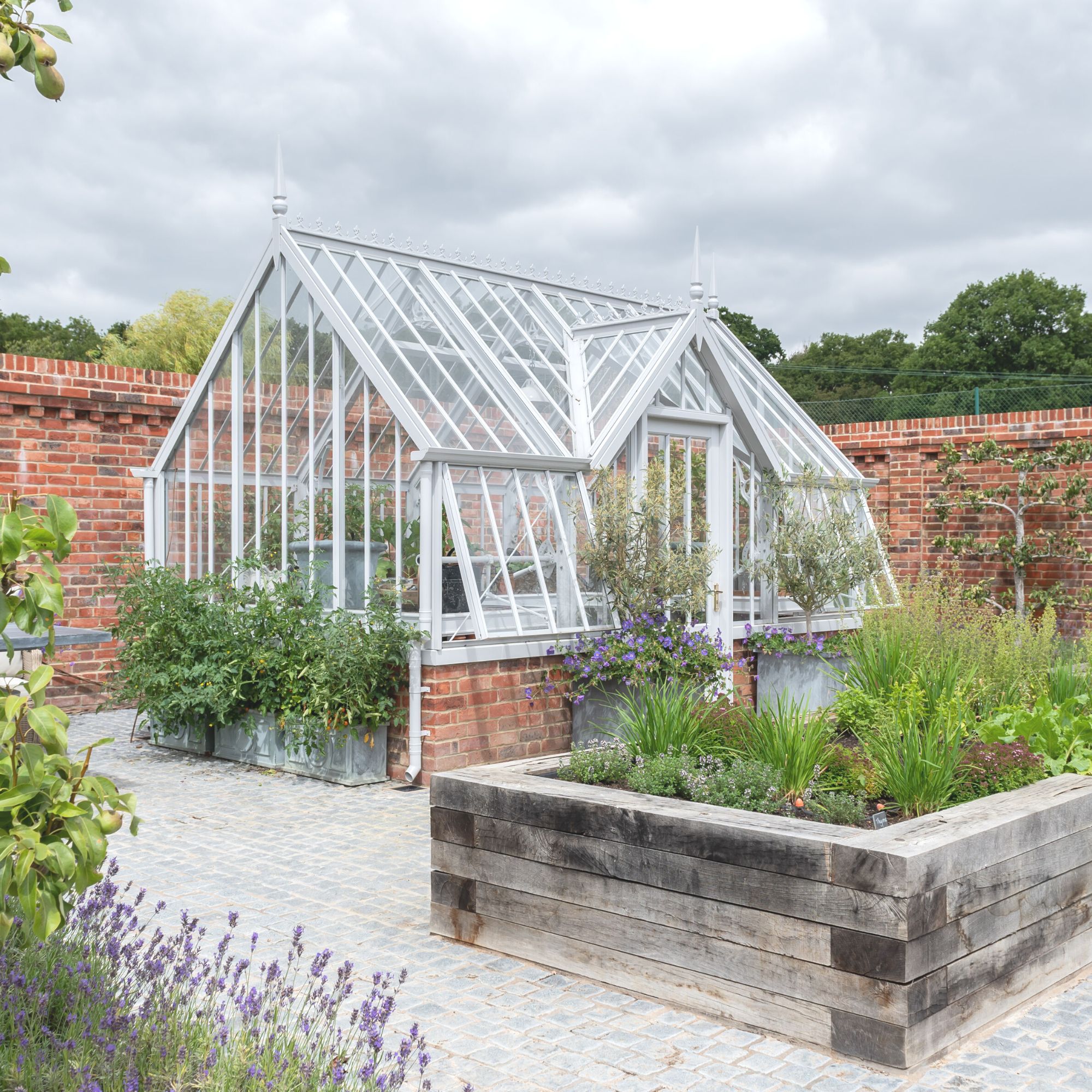Everything you need to know before buying a greenhouse
A greenhouse will prove invaluable to your gardening practices. Before adding one to your garden, however, make sure you consider the essentials to guarantee success


Buying a greenhouse is no small task. It is one of the more costly additions to the garden, so it is vital that you opt for the right design, materials, placement and position. However, with so many greenhouse ideas from which to choose, it can feel overwhelming.
Whether you are planning on learning how to grow your own vegetables or want to embrace tropical garden ideas, a greenhouse is a great way to increase the productivity and variety within your garden.
To help you find the right fit for your plot, we've asked the experts for their top tips when buying a greenhouse.
Everything you need to know before buying a greenhouse
As the calendar turns to June, it feels as though the good weather will never end. The garden is entering its height, filled with a profusion of life and colour. However, it cannot last. Winter will come and the garden will enter another period of slumber. But this doesn’t mean that you can’t keep enjoying the benefits of the garden.
Even with an unheated greenhouse, you can delay the effects of frost by several weeks, maximising the yield of crops and protecting plants from frost and dampness. A heated greenhouse will help you continue your horticultural efforts throughout the bleakest months, let you cultivate tropical or sub-tropical plants and start the growing and harvest periods by several weeks. That's why greenhouses are worth the investment.
Plus, adding a greenhouse is a great way to prep your garden for spring as you'll be able to use it to start off seedlings – something that is extremely useful if you're planning on growing tomatoes in pots.

What are the types of greenhouses?
While there are endless designs, sizes and shapes, there are only three main styles of greenhouses. These are: lean-to, abutting and freestanding – each has its own benefits and drawbacks.
Get the Ideal Home Newsletter
Sign up to our newsletter for style and decor inspiration, house makeovers, project advice and more.
- Freestanding is the classic design and stands on its own base – whether soil or slabs. It can be any shape and size.
- Lean-to greenhouses require a pre-existing structure – such as a garden wall, house or shed – to support it. Highly compact, it can also benefit from the residual heat from the wall, which will bolster the plant’s growth.
- Abutting greenhouses are a mix of freestanding and lean-to designs. Like a freestanding design, it stands on its own, but its fourth side is made up of an existing wall.

Should a greenhouse be in full sun all day?
Yes, if possible your greenhouse should be in full sun all day – this is true if you are adding a greenhouse to your south-facing garden or are hoping to incorporate one as part of your North-facing garden ideas.
‘Your greenhouse needs access to as much sunlight as possible during all seasons of the year, so positioning is an important consideration. Avoid locating your greenhouse in the shadow of tall trees, boundary fences or walls as these will obstruct light. For lean-to greenhouses placed against a wall, a south-facing position is ideal. For stand-alone structures, the ridge along the top of the greenhouse should ideally run from East to West, this will allow the sun to run along its longest side during the day,' explains Tom Barry, CEO of Hartley Botanic.
However, light isn't the only factor that will influence your garden landscaping. 'Other elemental considerations include a location to catch prevailing winds for ventilation purposes and choosing a site which is not shaded, but equally not too exposed to the cold. Site your greenhouse in close proximity to electricity (if utilising) and water supply, and on fertile soil if you want to install growing beds.'

What materials are used to make a greenhouse?
The material used for your greenhouse will impact its price, aesthetic and durability.
- Aluminium frames provide a secure, neat framework and can offer slimmer sightlines – thus maximising the amount of glazing. Lightweight, aluminium frames will need to be attached to the base with screws. It is also highly durable and will not rot, fade or warp. ‘Aluminium has very few downsides, although it does conduct heat meaning insulation may be somewhat slightly affected, and it is often a more expensive material to use,’ says Daniel Carruthers, director of Cultivar Greenhouses.
- Wood offers a traditional look and will blend perfectly with any style of garden. ‘It is also thermally efficient and provides strong insulation properties, meaning your greenhouse will maintain a steady internal temperature and it may be cheaper to heat during the winter,’ explains Daniel Carruthers. ‘However, the humid atmosphere can cause structures to warp and rot with time, and often requires resealing every few years to extend its life.’
- Modified timber, most popularly Accoya, combines the aesthetic of solid wood with the durability of metal. Exceptionally stable, it is rot-resistant, and will not warp, swell or shrink. ‘Accoya is also 30% more thermally efficient than other typical hardwoods, providing the best-growing conditions for your plants’ adds Daniel Carruthers.
- Galvanized steel is characterised by its strength and weight meaning it is very sturdy – plus it is more affordable than aluminium. ‘Despite these properties, it can be susceptible to rust, and the heaviness of the material also makes it difficult to handle and install. It’s also hard to drill into, which makes it difficult to easily add fixings to help support your precious plants,’ adds Daniel Carruthers.
- Plastic greenhouses offer a budget-friendly option and are easy to install. However, this does mean a compromise on durability and will likely only last a few years.
If opting for DIY greenhouse ideas, wood or plastic are easy and cost-effective options that will help you to get growing for less.

What is the best foundation for a greenhouse?
The right base can have transformative effects on your greenhouse’s security and longevity. Greenhouses have an open or integral base. ‘An integral base provides greater strength and stability which is ideal if your garden is exposed to strong winds. An integral base will also allow you to site your greenhouse on prepared soil. If we had to choose, we’d always recommend choosing a greenhouse with an integral base,’ explains Andrew White, service manager at Rhino Greenhouse. Open bases, as their name suggests, rely on solid foundations.
Once you know your base, you need to think about the foundations. This is typically hard-standing or soil. ‘Hard-standing bases generally consist of either paving slabs, a concreted area or a brick/block perimeter plinth, each will provide a stable, long-lasting foundation but will cost money. Hardstanding bases are helpful if you are trying to level out a sloping or uneven site, as the hardstanding can be built up or dropped down to make a level base for your greenhouse.’
Alternatively, you can opt for a soil base. This is cheaper and allows you to grow directly into the ground which has both benefits and drawbacks depending on the soil type. However, only particularly durable greenhouses can withstand a less secure soil base.
The compromise is a perimeter base as ‘it provides the benefit of a secure footing for your greenhouse, but allows natural drainage in your greenhouse, or the opportunity to grow straight into the soil,’ adds Andrew White.

Which material is generally used for greenhouse glazing?
When it comes to glazing, your main options are perspex or glass.
Perspex is favoured for its lightweight, shatter-resistant durability and affordability. For most gardeners, perspex will be more than suitable, however, if you are creating a professional growing environment, however, then glass is the way to go – ‘glass is far more effective than Perspex or acrylic at trapping the heat within a greenhouse and providing an insulated environment,’ Paul Hewitt, customer care manager at Alitex.
‘If cleaned properly, glass maintains its transparency and doesn’t discolour with age, meaning that light transmission isn’t affected, and your plants are able to absorb all that sunlight,’ says Paul Hewitt. There are also self-cleaning options that use the sun’s UV rays to clear dirt. Always ensure that greenhouse glass is safety glass so that it will shatter safely if broken, rather than splintering and leaving small shards.

How do you ventilate a greenhouse?
'One of the most common reasons for plant failure in Greenhouses is due to insufficient ventilation' warns Tom Barry from Hartley Botanic.
'Ventilation is maximised and prioritised for the number and position of vents being determined according to the specific needs of each bespoke structure. Our Victorian range comes with automatic vents and our other models come with manual ventilation as standard.'
Can I build a greenhouse without planning permission?
Yes, in the majority of cases, you can build a greenhouse without planning permission as they are classed as permitted development. However, there are some limits: it must be one storey; needs to be less than 2.5m tall and not disproportionate to the size of your house. If you live in a Conservation Area or your home is listed then additional rules will apply restricting size, design and location. For more information visit planningportal.co.uk.

Holly is one of Ideal Home’s content editors. Starting her career in 2018 as a feature writer and sub-editor for Period Living magazine, she has continued this role also adding regular features for Country Homes & Interiors and the Ideal Home website to her roster. Holly has a passion for traditional and country-inspired interiors – especially kitchen design – and is happiest when exploring the countryside and hills of the Lake District. A keen gardener, she is a strong believer that you can never have too many houseplants.
-
 I tried out this neat little dehumidifier for a month – it dried my laundry in half the time
I tried out this neat little dehumidifier for a month – it dried my laundry in half the timeThe 20L SmartAir Dry Zone dehumidifier tackled my laundry drying woes head on
By Jenny McFarlane
-
 I’m seeing pastel garden furniture at all my favourite brands this spring, but QVC’s sorbet collection impressed me the most
I’m seeing pastel garden furniture at all my favourite brands this spring, but QVC’s sorbet collection impressed me the mostFresh pastel shades are a great way to liven up your outdoor space
By Kezia Reynolds
-
 Don't tell my flatmates, but Joseph Joseph's clever new sink range finally made me enjoy washing up
Don't tell my flatmates, but Joseph Joseph's clever new sink range finally made me enjoy washing upI didn't know stylish washing up accessories existed until I saw this collection
By Holly Cockburn